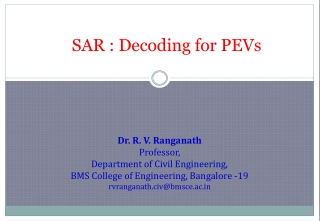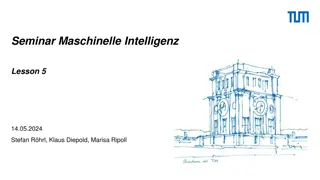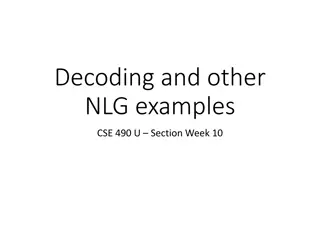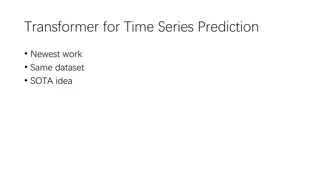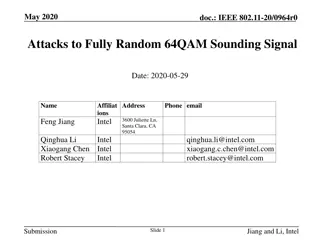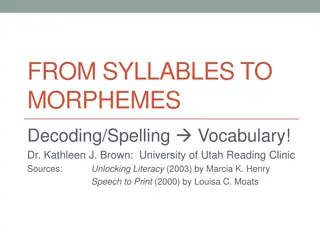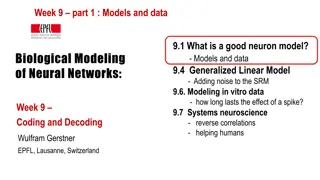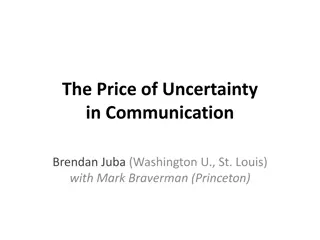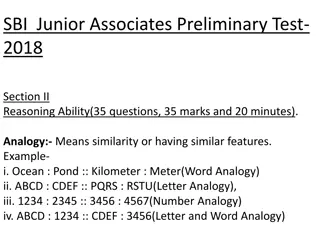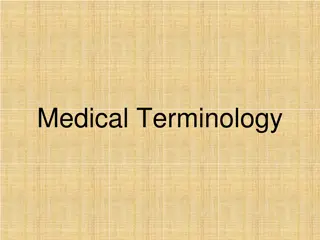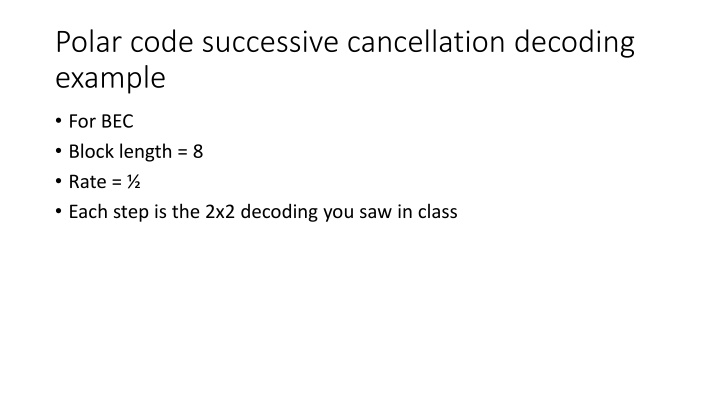
Polar Code Successive Cancellation Decoding for Binary Erasure Channel
Explore an example of Polar Code Successive Cancellation Decoding for a Block length of 8 with each step being a 2x2 decoding process. Follow the decoding steps to see how the information is decoded for a Binary Erasure Channel, represented through a series of images.
Download Presentation

Please find below an Image/Link to download the presentation.
The content on the website is provided AS IS for your information and personal use only. It may not be sold, licensed, or shared on other websites without obtaining consent from the author. If you encounter any issues during the download, it is possible that the publisher has removed the file from their server.
You are allowed to download the files provided on this website for personal or commercial use, subject to the condition that they are used lawfully. All files are the property of their respective owners.
The content on the website is provided AS IS for your information and personal use only. It may not be sold, licensed, or shared on other websites without obtaining consent from the author.
E N D
Presentation Transcript
Polar code successive cancellation decoding example For BEC Block length = 8 Rate = Each step is the 2x2 decoding you saw in class
0 ? 0 0 0 0 ? 0 0 0 ? 0
0 ? 0 0 0 0 ? 0 0 0 ? 0
? 0 ? 0 0 0 0 ? 0 0 0 ? 0
? 0 ? 0 0 0 0 ? 0 0 0 ? 0
? 0 ? 0 0 0 0 0 ? 0 0 0 ? 0
? 0 ? 0 0 0 0 0 ? 0 0 0 ? 0
? 0 ? 0 0 0 ? 0 0 ? 0 0 0 ? 0
? 0 ? 0 0 0 ? 0 0 ? 0 0 0 ? 0
? 0 ? 0 0 0 ? 0 0 ? ? 0 0 0 ? 0
? 0 ? 0 0 0 ? 0 0 ? ? 0 0 0 ? 0
? ? 0 ? 0 0 0 ? 0 0 ? ? 0 0 0 ? 0
? ? 0 ? 0 0 0 ? 0 0 ? ? 0 0 0 ? 0
? ? 0 ? ? 0 0 0 ? 0 0 ? ? 0 0 0 ? 0
? ? 0 ? ? 0 0 0 ? 0 0 ? ? 0 0 0 ? 0
? ? ? 0 ? ? 0 0 0 ? 0 0 ? ? 0 0 0 ? 0
? ? ? 0 ? ? 0 0 0 ? 0 0 ? ? 0 0 0 ? 0
? 0 ? 0 ? ? 0 0 0 ? 0 0 ? ? 0 0 0 ? 0
? 0 ? 0 ? ? 0 0 0 ? 0 0 ? ? 0 0 0 ? 0
? 0 ? 0 ? ? 0 0 0 ? 0 0 ? ? 0 0 0 ? 0
? 0 ? 0 ? ? ? 0 0 0 ? 0 0 ? ? 0 0 0 ? 0
? 0 ? 0 ? ? ? 0 0 0 ? 0 0 ? ? 0 0 0 ? 0
? 0 ? 0 ? 0 ? 0 0 0 ? 0 0 ? ? 0 0 0 ? 0
? 0 ? 0 ? 0 ? 0 0 0 ? 0 0 ? ? 0 0 0 ? 0
? 0 0 0 ? 0 0 0 0 0 ? 0 0 ? ? 0 0 0 ? 0
? 0 0 0 ? 0 0 0 0 0 ? 0 0 ? ? 0 0 0 ? 0
? 0 0 0 ? 0 0 0 0 0 0 ? ? 0 0 0 ? ? 0 0 0 ? 0
? 0 0 0 ? 0 0 0 0 0 0 ? ? 0 0 0 ? 0 ? 0 0 0 ? 0
? 0 0 0 ? 0 0 0 0 0 0 ? ? 0 0 0 ? 0 ? 0 0 0 ? 0
? 0 0 0 ? 0 0 0 0 0 0 ? ? 0 0 0 ? 0 ? 0 0 0 ? 0
? 0 0 0 ? 0 0 0 0 0 0 0 ? 0 0 0 ? 0 ? 0 0 0 ? 0
? 0 0 0 ? 0 0 0 0 0 0 0 ? 0 0 0 ? 0 ? 0 0 0 ? 0
0 0 0 0 ? 0 0 0 0 0 0 0 0 0 0 0 ? 0 ? 0 0 0 ? 0
0 0 0 0 ? 0 0 0 0 0 0 0 0 0 0 0 ? 0 ? 0 0 0 ? 0
0 0 0 0 ? 0 0 0 0 0 0 0 0 0 0 0 0 0 ? 0 0 0 ? 0
0 0 0 0 ? 0 0 0 0 0 0 0 0 0 0 0 0 0 ? 0 0 0 ? 0
0 0 0 0 ? 0 0 0 0 0 0 0 0 0 0 0 0 0 ? 0 0 0 0 ? 0
0 0 0 0 ? 0 0 0 0 0 0 0 0 0 0 0 0 0 ? 0 0 0 0 0 ? 0
0 0 0 0 ? 0 0 0 0 0 0 0 0 0 0 0 0 0 ? 0 0 0 0 0 0 ? 0
0 0 0 0 ? 0 0 0 0 0 0 0 0 0 0 0 0 0 ? 0 0 0 0 0 0 ? 0 0
0 0 0 0 ? 0 0 0 0 0 0 0 0 0 0 0 0 0 ? 0 0 0 0 0 0 0 ? 0 0
0 0 0 0 ? 0 0 0 0 0 0 0 0 0 0 0 0 0 ? 0 0 0 0 0 0 0 0 ? 0 0
0 0 0 0 ? 0 0 0 0 0 0 0 0 0 0 0 0 0 ? 0 0 0 0 0 0 0 0 0 ? 0 0
0 0 0 0 ? 0 0 0 0 0 0 0 0 0 0 0 0 0 ? 0 0 0 0 0 0 0 0 0 0 ? 0 0
0 0 0 0 ? 0 0 0 0 0 0 0 0 0 0 0 0 0 ? 0 0 0 0 0 0 0 0 0 0 0 0 ? 0 0 0 0
And so we succeed!!! If we fail to decode ??for some ?, we declare failure as we can t go ahead. Note that this can be suboptimal because some of the upcoming bits might be frozen and hence useful for decoding ??. But we assumed all the bits yet to come are random when we decoded ??. That being said, SC decoding can be shown to achieve capacity. Situation for other channels like BSC is slightly more complicated but the basic concepts remain the same. For short block lengths, we can do better, e.g., using list decoding and CRCs (see https://ieeexplore.ieee.org/document/7055304). These are one of the best codes at short block lengths and are part of 5G standards. Note that a lot of computation is reused and hence the complexity of decoding is ?(? log ?) where ? is the block length (so ? is the vertical height in the previous figures and log ? is the horizontal width). https://ieeexplore.ieee.org/document/7055304


